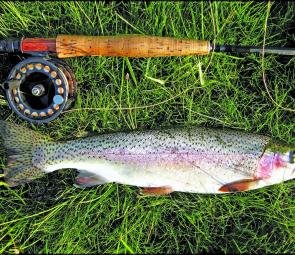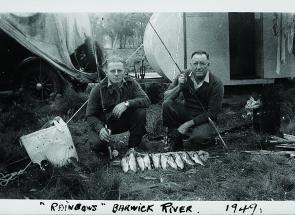The 2011-12 New England trout season opened to some excellent reports. Throughout the Winter constant stream flows were generally better than average and the quality of fish has been terrific.
The work of the pioneer stocking societies back in the late 1800s gave us the fishery we have today, one which should be preserved through constant management.
The New England region has stream angling to rival anywhere in Australia. However, most visitors head to the traditional hotspots for crowded, over-pressured fish. Take the time to seek out your own headwater streams and the rewards are there.
Down Walcha way, the continual flows have meant cold water right into the Spring, with fish responding to lures and flies.
Given the water heights, one of the more popular lure patterns has been the crawdad or crayfish imitation. Originally produced by Rebel, there are now plenty of copies which work well.
The tight shimmy action really turns on early season fish, especially when the water is up or coloured.
Fly flickers will find good success on large Woolly Buggers stripped ultra-slowly. These flies need a little weight, such as a bead head, to get down. Stripping slowly means you’ll foul the bottom, so carry a handful of these flies.
Early season fish are quite susceptible to bright patterns so fluoro green and pink will draw attention.
The Cobrabald River watershed has always been a hot spot, with the willows and reed beds providing plentiful cover and food. The fish here are healthy and pull hard.
The reaches above the Aberbaldie Road are particularly fruitful searching waters.
The Ebor streams have been on fire as well. Whether the open spring creeks or down in the gorges, the fish have been active.
The Guy Fawkes River upstream of the bridge has been giving up a few fish at first and last light to anglers with a cautious approach.
This stretch of water does get a hammering and the fish are well educated. However, because of its proximity to the town, many anglers are new chums to the game.
Fishing small weighted nymphs to active fish is the key.
I will sit for a long time watching this stretch of water. Just a single rise will allow the observant angler to find a target.
You’ll often only get one or two shots here until the fish are put down so be prepared!
The region’s superb impoundment fishing will kick into gear this month.
Copeton Dam is a popular early Summer fishery.
While the blue-green algae blooms back in late September have cleared, be aware of the possibility. Particularly in the upper reaches, where the waters are sheltered from the wind, you may find patches of algae. If so, give the area a miss and head down into the main basin.
Warmer water will mean the action moves to the flats and shallow timbered areas.
Bankside anglers will do well with a shrimp or two pinned under a bubble float. This is a terrific option for families as the weather is not too hot and the fishing fairly casual.
Keen boaties would do well to focus trolling medium-sized lures along the drop-offs. Look for water with scattered structure in 3m to 4m.
If you don’t have a sounder, your lures should bounce along the bottom occasionally. A selection of lures with various bib sizes allows you to be flexible.
Always carry a file or stone and constantly touch up your hook points. This type of search trolling is hard on hooks and when you do get a hit, you want the best chance at hooking up.
Remember that cod are still off limits so return any fish encountered to the water.
However, some solid Spring yellows could be in the offing.
Cast to mid-water structure with smaller spinnerbaits. Fire tiger and chartreuse are the most favoured colours while bronze or gold blades are preferable.
An extra-large meshless net is the best option for handling fish to be released.
The Copeton redfin should start attacking everything in sight. These mini-piranhas can be the bane of anglers rigged up for golden perch.
However, if you get onto a patch with a boatful of kids they can save the day. Jigging as you would for deep-water bass is a proven tactic but medium-sized lures can also be cast or trolled for a result.
When the breeze is light, drifting the flats and casting smaller lures is a terrific option. Expect to hit fish in 2m to 3m depths wherever there are weed beds.
Shallow-diving lures cast across the top of the submerged weed should raise fish.
Spring fish love a little colour so paint jobs with pink or yellow predominating are a good starting point.
The northern and eastern shorelines probably offer the most options for this strategy. Although a boat greatly assists in putting you on the deepwater side of the beds, shore-based casting also works.
Similar tactics will be useful at Keepit and Split Rock dams, although the latter lacks the extensive flats. Even so, work the upper ends of both impoundments, trolling hardbodies or flicking spinnerbaits into the timber.
It will be only another month then the carp start to fire up.
Before you moan about stinking swamp trout, grab the kids and a tin of corn kernels for one of the most fun afternoons you’ll ever have.
These fish pull like Mack trucks and your little ’uns will squeal all arvo.
Fly anglers will find a heap of entertainment stalking the flats. Chaffey Dam continues to be my venue of choice as the water is generally clearer and the western shoreline is firm.
Since bass came back on the fishing calendar there have been scattered reports. For some time throughout late September the Macleay ran a little high and bankside options were limited.
Most success came from drifting the river and peppering submerged structure below the runs.
Early season bass are suckers for a sub-surface offering. Fish hard against the structure and be prepared to sacrifice the occasional fly or lure to snags.
Given the fantastic Spring conditions I expect a major cicada hatch in coming months. From the western side of the Ranges and down to the coast, everything from the greenback Murray cod to estuary bass will be munching poppers.
In past years I have outlined the numerous options to access some of the best gorge bass fishing waters in this State. Whether on private land or in national parks, you’ve a wealth of options. Perhaps we’ll have a refresher course in a coming issue.
A local fishing nut recently told me he had cracked the code of nailing freshwater mullet on fly. I have spent the odd frustrating effort when the bass were quiet trying to tempt some quite sizeable specimens with no luck.
Apparently small poppers fished quite quickly on a high stick will bank plenty. Reminds me of the popper/whiting tactics anglers now employ in the estuaries.
I’m keen to give it a go on my upcoming foray into the gorges.
Reads: 3433
Early season trout are fit and full of fight for New England anglers.

Two happy campers from the 1949 season. Ebor continues to provide excellent sport.

The Cobrabald River is a mainstay of the Walcha fishery.

Long, quiet pools like these are prime spots to target. Work yabby patterns deep and slow.




